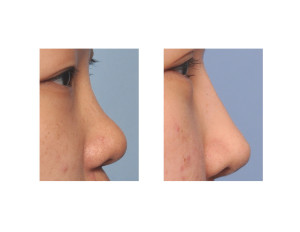Background: Rhinoplasty often involves augmentation maneuvers to raise the profile of the nose. This is true in many ethnic rhinoplasties, particularly Asians noses. With short nasal bones and a flatter dorsum, the entire profile of the nose can be more recessed. A low dorsum is often associated with a flatter and broader nasal tip as part of the overall underdevelopment of the nasal structures.
In Asian rhinoplasty, a more refined and prominent nose involves augmentation of the dorsum (bridge) as well as that of the nasal tip. The entire profile of the nose needs to be built up from the radix down to the tip. The tip needs to be elevated with a longer columella and nostrils that are not overly wide.
Creating these changes in Asian rhinoplasty requires increased structural support. This can come from using the patient’s own natural cartilage or that of a synthetic implant. There are surgeons who are advocates of both types of nasal augmentation methods. By far synthetic implants are more widely used because of their simplicity and lack of the need for a donor site. Rib grafts require a very motivated patient who can tolerate the donor site and a surgeon who is experienced in how to shape the graft with a low incidence of warping and graft asymmetry.
Case Study: This 19 year-old Asian female wanted to augment her flat nose with little profile. She needed little time to opt for a rib graft given her young age and the desire for a nasal augmentation method that would pose no long term risks of infection or extrusion.


The solid carved dorsal rib graft can be effective in dorsal augmentation when the rib harvested is of sufficient length and not unduly curved. Unfortunately this is not that commonly encountered and careful carving may not always prevent the thinner end of the graft from developing some slight curvature or asymmetry. When in doubt the rib graft should be diced and wrapped in Surgical or fascia.
Highlights:
1) Asian rhinoplasty usually involves augmentation of the bridge (dorsum) and the tip of the nose.
2) The primary augmentation method of the dorsum in Asian rhinoplasty could be a synthetic implant or a rib graft.
3) The rib graft in rhinoplasty can be used as either a carved solid cartilage graft or wrapped diced cartilage.
Dr. Barry Eppley
Indianapolis, Indiana


